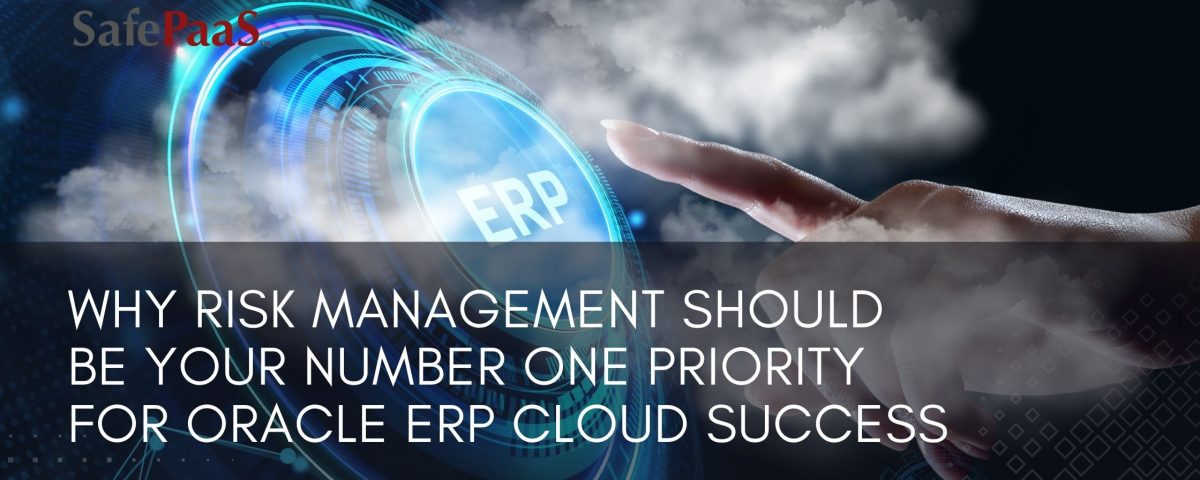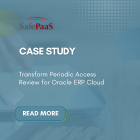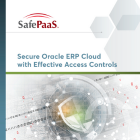Why risk management is key for Oracle ERP Cloud Success


"Go live" is a crucial step in any digital transformation project. However, the path to a successful Oracle ERP cloud go-live is challenging and can even lead to incomplete or failed implementations, missed objectives, and potential security and control vulnerabilities. This guide highlights why risk management should be your number one priority to ensure a secure and smooth go-live along with other key considerations that should be addressed upfront in an Oracle ERP Cloud project.
By following these guidelines and engaging in careful discussions with your System Integrator (SI), you can pave the way for a transformative and successful ERP journey and achieve your business objectives.
Consideration 1: ERP Project Planning
Security, controls, and compliance are critical considerations that cannot be ignored in an Oracle ERP Cloud project. You can safeguard sensitive data and mitigate risk by embedding risk management and controls into an ERP project. The following measures should be considered:
Embedding Controls
First and foremost, during ERP project planning, it's essential to consider internal controls and security in addition to testing. Neglecting to include controls in the design of your implementation in your planning phase phases can cause significant problems. Unfortunately, many organizations postpone designing security and controls until a later phase, which leads to higher costs and complications. To avoid these types of issues, it's recommended that you proactively include controls and security design from the beginning of your project to ensure that it stays on time and within budget.
Policy-based Access Controls (PBAC)
PBAC enables you to restrict access to data and functionality based on an individual’s job responsibilities and policies.
Segregation of duties
Segregation of Duties is another key component of an effective Oracle Cloud ERP security strategy. This involves ensuring that no single individual controls all aspects of a particular process, thereby reducing the risk of fraud or error.
Multi-factor Authentication
Another essential element of a strong Cloud ERP security framework is multi-factor authentication (MFA), which is a process that requires users to provide two or more forms of identification when logging into the system. This helps to ensure that only authorized individuals can access the system and that their identities are verified.
Least privilege or Adhering to the Principle of Least Privilege
Granting users only the minimum level of access required to perform their job functions is also crucial. This helps limit the risk of unauthorized access to sensitive data and ensures that users can only access the data they need to do their jobs.
Testing
Finally, rigorous testing is essential to ensure your Oracle ERP Cloud complies with regulatory requirements. This includes conducting regular audits to identify any vulnerabilities or weaknesses in the system and taking steps to address them quickly.
Consideration 2: Audit Preparedness
When preparing for audits, it's important to remember that this is not a one-time event but a continuous process that starts during the ERP implementation phase. To ensure audit readiness, it's essential to take some crucial steps that can help mitigate risks and ensure compliance with audit requirements.
First and foremost, it's important to map your organizational rules to ensure they align with your audit requirements. This can help identify potential gaps in your processes and ensure all relevant controls are in place. Implementing segregation of duties controls can also help prevent fraud and errors by ensuring that no single individual has complete control over a particular process.
Another important step to ensure audit readiness is proactively monitoring system changes. This can help identify any unauthorized access or changes made to the system, ensuring that any potential issues are addressed before they become bigger problems.
In addition, customized roles can also ensure compliance with audit requirements. By creating roles tailored to specific functions within your organization, you can ensure that individuals only have access to the data and systems relevant to their job duties.
Finally, a monitoring solution can help you watch all system activities and flag suspicious behavior. By leveraging these solutions, you can quickly identify potential issues, take appropriate actions to reduce risks and ensure compliance with audit requirements.
Engaging with a reliable Risk Advisor
is crucial for a successful ERP implementation.
However, certain gaps may arise during the project lifecycle that necessitate careful consideration and discussion:
- Minimizing License Costs: Discuss strategies for optimizing license usage without compromising system functionality. Explore ways to manage license overages and customize roles that effectively align with organizational needs.
- Security and Controls: Ensure that security and controls, such as segregation of duties and sensitive access, are adequately addressed within the project budget and timeline. Seek assurances regarding the expertise of SI resources, but leveraging expertise from Risk Advisors is recommended.
- Training and Patch Management: Clarify the inclusion of training and planning for quarterly patch processes within the project scope and request details on the training provided and templates available to facilitate a smooth transition and ongoing maintenance.
- Change Management and Scope Creep: Discuss the potential for change orders and seek transparency regarding past implementations. Evaluate the referenceability of previous projects and assess the SI's commitment to delivering within scope and budget constraints.
Consideration 3: Does the Implementation Meet Organizational Objectives?
A successful ERP implementation is a critical undertaking for any organization. The implementation must align closely with your organizational objectives and business strategy. Doing so can result in operational efficiencies, enhanced customer responsiveness, reduced manual processes, and seamless integration with other systems.
Oracle ERP Cloud should be tailored to your organization's unique needs, not deployed in a "one-size-fits-all" approach. A successful implementation should focus on optimizing business processes, streamlining operations, and providing accurate, up-to-date information to decision-makers. This can enable the organization to make informed decisions quickly, based on accurate data, and with the confidence that the information is reliable.
Ensuring business continuity during the implementation is also key. Oracle ERP Cloud implementations should not disrupt operations or productivity. A well-planned and executed implementation strategy will minimize downtime, maintain business continuity, and manage risks effectively.
Data is critical to a successful ERP implementation, operational efficiencies, and business continuity. Oracle ERP Cloud should enable clear, consistent data for informed decision-making. Data accuracy, completeness, and timeliness are essential for effective decision-making. Therefore, ERP Cloud should provide real-time access to data that is easily accessible, comprehensive, and reliable.
For a successful implementation of Oracle ERP Cloud, it is crucial to have a well-planned strategy that aligns with your organizational goals. This strategy should prioritize optimizing business processes, streamlining operations, and providing accurate and up-to-date information to decision-makers. It is also necessary to ensure business continuity and facilitate consistent data for informed decision-making. If you don't meet these objectives, you may not be able to achieve the expected benefits from your implementation.
Consideration 4: Sustainable Maintenance
A well-defined change control process must be in place to ensure the sustainable maintenance of Oracle Cloud ERP. This process should include a structured patch management strategy, which helps to ensure that all updates are properly managed and applied.
Regular updates and comprehensive testing are key components of ensuring system stability and mitigating any risks associated with software vulnerabilities. Keeping the system up-to-date can address potential vulnerabilities before bad actors can exploit them. Furthermore, comprehensive testing of any changes or updates can help identify potential issues and ensure that the system remains stable.
Identifying and prioritizing changes is another important aspect of maintaining Oracle Cloud ERP. By prioritizing modifications based on their impact and urgency, IT teams can ensure that the most critical issues are addressed first. Additionally, robust compliance measures are essential for long-term success. These measures should ensure that all changes and updates are performed securely and controlled, minimizing the risk of any negative impact on the system.
Consideration 5: Long-term Cost of Ownership
Understanding the long-term cost of owning an ERP system is crucial for financial planning and budgeting. Favorable contract terms, license usage monitoring, and role customization are important ways to minimize costs without compromising functionality.
Negotiating favorable terms in the contract can help you obtain better pricing, payment terms, and maintenance fees. You can also negotiate for additional features or services that align with your business needs.
Monitoring license usage is another critical aspect of managing ERP costs. You can eliminate unnecessary expenses by tracking the number of licenses in use and identifying any underutilized licenses. You can also explore options for reducing the number of licenses required by consolidating roles or implementing self-service functionality.
Optimizing role customization is another way to reduce ERP costs while maintaining functionality. By tailoring roles to specific business needs, you can eliminate unnecessary access to features and functions that are not required. This can help reduce license costs and minimize the risk of unauthorized access to sensitive information.
Proactive monitoring and role-based budgeting are also important to ensure your organization remains financially viable throughout the ERP lifecycle. By regularly reviewing usage and costs, you can make informed decisions about future investments and ensure that the ERP system continues to meet business needs while staying within budget.
Closing the Gap: Insights from Practitioners
When you implement Oracle ERP Cloud, you may encounter several critical challenges that can hinder your project's success. Examining the implementation process can illuminate these obstacles and help you better understand how to overcome them.
In particular, customization, roles, and post-go-live support are three areas that require close attention. Customization refers to how you can tailor the ERP cloud solution to specific needs. In contrast, roles refer to the different responsibilities and permissions assigned to users within the system. Post-go-live support is crucial for ensuring that any issues or problems that arise after the ERP Cloud solution has been launched are addressed promptly and effectively. You can improve your chances of achieving a successful ERP Cloud implementation by gaining deeper insights into these key areas.
Role Customization: Implementing Oracle ERP Cloud is a complex process that requires careful planning and execution. One common approach organizations use is to rely on pre-built or seeded roles to provide users with the necessary access to perform their job functions. However, this approach has inherent shortcomings.
These pre-built roles are often generic and may not align with your organization's specific needs and requirements. As a result, extensive remediation efforts are required post-go-live to ensure users have the appropriate access to the ERP system. This can lead to additional costs and delays, which can be detrimental to the implementation's success.
Customization efforts are often necessary to address this issue and align the pre-built roles with your organizational needs. However, these cleanup efforts can be complex, time-consuming, and expensive. You must carefully evaluate the implications of pre-built roles before embarking on this path.
While pre-built roles have benefits, they may not be sufficient for organizations requiring a more tailored ERP implementation approach, and they contain inherent conflicts in the segregation of duties. Customization efforts to align roles with organizational needs may be necessary, but they should be carefully evaluated to ensure that they are feasible and cost-effective.
Post-Go-Live Remediation: After the go-live phase, organizations often face significant challenges in role remediation and license management. This is mainly because roles may require extensive rework to eliminate unnecessary privileges, mitigate risks associated with over-provisioning, and maintain compliance with regulations.
Organizations that fail to plan and allocate budgets for post-go-live cleanup, risk, compliance breaches, and unexpected costs. Auditors may impose severe penalties and fines, while the organization may have to bear the cost of rework and remediation.
Therefore, your organization must carry out regular assessments of roles and privileges, identify and eliminate unnecessary privileges, and ensure that only authorized users have access to sensitive data and systems. You should also have a well-defined license management process, including regular license and subscription audits, to avoid any compliance issues.
By taking a proactive approach toward role remediation and license management, your organization can minimize the risk of compliance breaches, reduce costs, and maintain a secure and compliant IT environment.
Role-based Budgeting and Audit Preparedness: Effective cost management is essential to your organization's operations. Role-based budgeting is a key tool that helps ensure that costs are kept under control over the long term. By assigning specific budgets to different roles within your organization, decision-makers can better manage expenses and optimize resource utilization.
However, simply implementing role-based budgeting is not enough. You must also be prepared for ongoing audits requiring continuous monitoring and role validation. This is often overlooked, resulting in audit risks that could have been mitigated with proper planning.
To avoid this, it is essential to have a strong security design and testing process during implementation. This will help identify potential vulnerabilities and ensure the system is secure and compliant. Engaging specialized expertise for comprehensive risk assessment is also important, as this can help identify and mitigate any potential risks before they become major issues.
Effective cost management requires a holistic approach that considers both short-term and long-term goals. By implementing role-based budgeting and ensuring ongoing audit preparedness, you can optimize resource utilization, control costs, and reduce audit risks.
Managing the complexities of an Oracle ERP Cloud go-live requires careful planning, collaboration, and proactive management. Your organization can maximize the value derived from its Cloud ERP investment by prioritizing objectives, ensuring security and compliance, sustaining maintenance efforts, managing costs effectively, and prioritizing audit readiness.
Engaging in open discussions with System Integrators to address potential gaps and concerns is crucial for achieving a successful and secure ERP cloud go-live. However, leveraging insights from practitioners and investing in post-go-live support is essential for bridging critical gaps and ensuring long-term success.
Top questions to ask your Systems Integrator by ERP Risk Advisors
- How do I determine my licensing needs and manage them?
- Given that seeded roles often hit multiple license buckets, how can I get rid of license overages without customizing roles?
- How will I know if the custom roles are built based on the principle of least privilege and will allow me to pass my audit?
- Will you train our team to handle the quarterly patch process? What training and templates will you provide us?
- Should I expect change orders?
Are you ready to ensure a seamless and secure Oracle ERP Cloud implementation?
Recommended Resources

Transform Periodic Access Review for Oracle ERP Cloud
Learn customer automated their PAR processes utilizing SafePaaS, focusing on their Oracle ERP Cloud system. They achieved significant benefits by leveraging SafePaaS functionalities that integrated with their existing systems, such as Microsoft Entra ID, ServiceNow, and their legacy Identity Security tool.

Secure Oracle ERP Cloud
This ebook outlines some of the major considerations in establishing and managing user access controls for Oracle ERP Cloud.

Top Threats Oracle ERP Cloud
This guide discusses the top five Oracle ERP Cloud security threats and provides insights on detecting and mitigating them. From access risk to insider threats and ineffective user provisioning, explore the challenges that ERP systems experience and offer actionable tips to strengthen your Oracle ERP Cloud security defenses.

